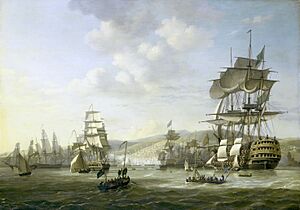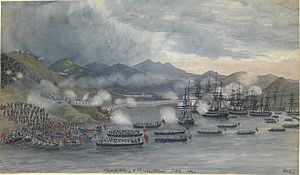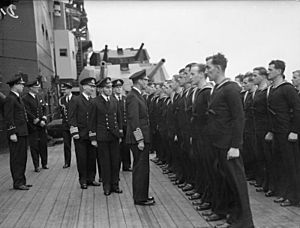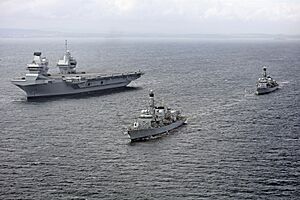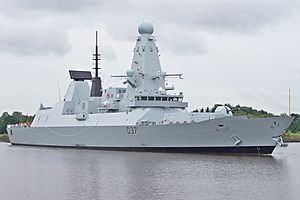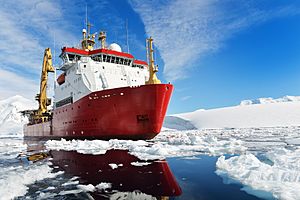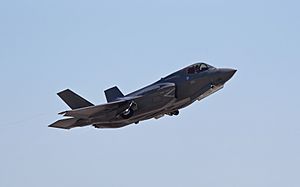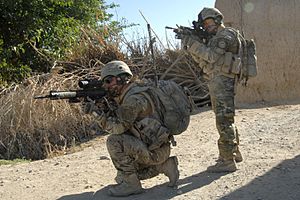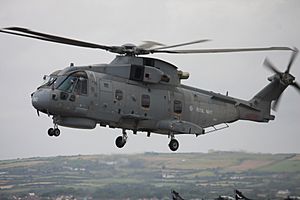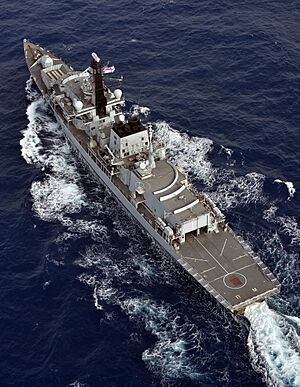Royal Navy facts for kids
Quick facts for kids Royal Navy |
|
|---|---|
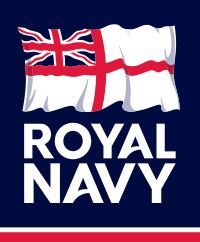 |
|
| Founded | 1546 |
| Country | |
| Type | Navy |
| Role | Naval warfare |
| Size |
|
| Part of | His Majesty's Naval Service |
| Naval Staff Offices | Whitehall, London |
| Nickname(s) | Senior Service |
| Motto(s) | "Si vis pacem, para bellum" (Latin) (If you wish for peace, prepare for war) |
| Colours | Navy blue White Gold |
| March | Quick – "Heart of Oak" Slow – Westering Home (de facto) |
| Fleet |
|
| Commanders | |
| Head of the Armed Forces and Lord High Admiral | |
| First Sea Lord and Chief of the Naval Staff | |
| Second Sea Lord and Deputy Chief of the Naval Staff | |
| Fleet Commander | |
| Warrant Officer to the Royal Navy | |
| Insignia | |
| White Ensign | |
| Naval jack | |
| Pennant | |
| King's Colour | |
| Aircraft flown | |
| Attack | Wildcat HMA2 F-35 Lightning II |
| Fighter | F-35 Lightning II |
| Patrol | Merlin HM2 Wildcat HMA2 |
| Reconnaissance | Commando Wildcat AH1 RQ-12A Wasp UAV RQ-20 Puma UAV Peregrine rotary-wing UAV |
| Trainer | Avenger T1 Juno HT1 Prefect T1 Tutor T1 |
| Transport | Commando Merlin HC4/4A |
The Royal Navy (RN) is the main naval force of the United Kingdom. It is part of His Majesty's Naval Service, and its officers get their authority from the King. While English and Scottish kings used warships from the medieval period, the first big sea battles happened during the Hundred Years' War against France. The modern Royal Navy started from the English Navy in the early 1500s. It is the oldest of the UK's armed services, which is why it's called the Senior Service.
From the early 1700s until World War II, it was the most powerful navy in the world. The Royal Navy helped build and protect the British Empire. It used strong bases and coaling stations around the world to keep its naval power. After World War I, its size was greatly reduced. During the Cold War, the Royal Navy mainly focused on hunting Soviet submarines. After the Soviet Union broke apart, its focus shifted to operations far from home.
The Royal Navy has advanced ships, submarines, and aircraft. This includes two aircraft carriers, four ballistic missile submarines (which carry the UK's nuclear deterrent), five nuclear fleet submarines, six guided missile destroyers, eight frigates, seven mine-countermeasure vessels, and twenty-six patrol vessels. As of July 2025, there are 62 active ships (including submarines and the historic HMS Victory) in the Royal Navy. There are also 11 ships from the Royal Fleet Auxiliary (RFA). The RFA helps Royal Navy warships at sea and provides ships for amphibious operations.
The Royal Navy is part of His Majesty's Naval Service, which also includes the Royal Marines and the Royal Fleet Auxiliary. The main leader of the Naval Service is the First Sea Lord, who is an admiral. The Royal Navy operates from three main bases in Britain: Portsmouth, Clyde, and Devonport. Devonport is the largest naval base in Western Europe. It also has two naval air stations, RNAS Yeovilton and RNAS Culdrose, where its aircraft are based.
Contents
- Royal Navy's Main Jobs
- History of the Royal Navy
- Royal Navy's Ships and People
- How the Royal Navy is Run
- Where the Royal Navy is Based
- Names and Titles
- Ranks and Insignia
- Customs and Traditions
- Navy Cadets
- See also
The Royal Navy has six main roles, as stated in 2017:
- Preventing Conflict – Working globally and regionally to stop wars.
- Providing Security At Sea – Keeping international trade routes safe and stable.
- International Partnerships – Strengthening ties with allies like NATO.
- Maintaining a Readiness To Fight – Being ready to protect the UK's interests worldwide.
- Protecting the Economy – Keeping important trade routes open for the UK and its allies.
- Providing Humanitarian Aid – Giving quick help during global disasters.
The Royal Navy protects British interests both at home and abroad. It carries out the government's foreign and defence plans through military actions, diplomacy, and other support. It is also a key part of Britain's contribution to NATO, with ships and aircraft always ready for NATO tasks.
Key Capabilities
In 2007, the Royal Navy's main abilities included:
- Keeping the UK's Nuclear Deterrent ready with submarines that are always at sea.
- Providing two medium-sized maritime groups with the Fleet Air Arm.
- Delivering the UK Commando force.
- Helping the Joint Aviation Command.
- Keeping up standing patrols around the world.
- Clearing mines for the UK and its allies.
- Providing sea mapping and weather services globally.
- Protecting Britain's Exclusive Economic Zone (the sea area where it has special rights).
The English Royal Navy officially started in 1546 under Henry VIII. However, the Kingdom of England had less organised naval forces for centuries before this. The Royal Scots Navy existed from the Middle Ages until it joined with the English Royal Navy in 1707.
Early Fleets
For much of the medieval period, fleets were often put together for specific battles and then disbanded. These were usually merchant ships used for war. England did not have a small, permanent group of warships in peacetime. This meant it was slow to get a fleet ready when war began.
In the 11th century, Aethelred II had a large fleet built by a national tax. During the time of Danish rule, a standing fleet was kept through taxes. After the Norman Conquest, English naval power weakened, and Vikings often raided England.
The need for an organised navy became clear during the First Barons' War. Prince Louis of France invaded England in 1216. Since King John could not organise a navy, the French landed easily. In 1217, the Earl of Pembroke gathered ships to fight the French in the Battle of Sandwich. This was one of England's first major sea battles. The Hundred Years War also showed how important an English fleet was.
Age of Sail and Global Power
A permanent "Navy Royal" with its own offices, dockyards, and warships began under Henry VIII. Under Elizabeth I, England fought Spain. Private ships joined the Queen's ships to raid Spanish trade and colonies. In 1588, the Royal Navy helped defeat the Spanish Armada.
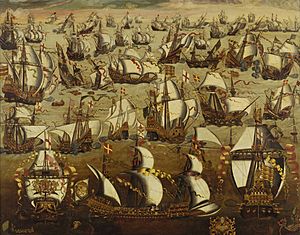
In 1603, England and Scotland became one kingdom under a single monarch. Their navies increasingly fought together. In the early 1600s, England's naval power declined until Charles I started a big shipbuilding program. His way of paying for the fleet helped cause the English Civil War.
The Commonwealth of England changed many names and symbols in the new Commonwealth Navy. It made the navy the most powerful in the world. The fleet was tested in the First Anglo-Dutch War (1652–1654) and the Anglo-Spanish War (1654–1660). These wars led to Britain taking Jamaica and successfully attacking Spanish treasure fleets.
When the monarchy was restored in 1660, Charles II renamed it the Royal Navy again. He also started using the prefix HMS. The Navy became a national institution, not just the King's property. After the Glorious Revolution of 1688, England joined the War of the Grand Alliance. This war ended France's short time as a sea power and began a long period of British naval dominance. This dominance helped create the British Empire.
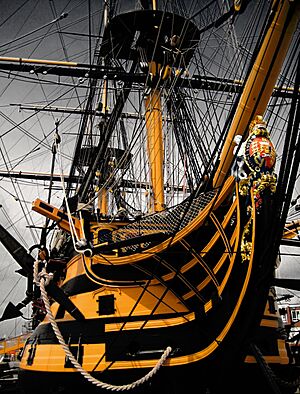
In 1707, the Scottish navy joined the English Royal Navy. Throughout the 1700s and 1800s, the Royal Navy was the largest navy in the world. It was better in funding, tactics, training, and ship design. The peace treaty after the War of the Spanish Succession (1702–1714) gave Britain Gibraltar and Menorca. These places gave the Navy bases in the Mediterranean. The Royal Navy's growth also encouraged British colonies in the Americas. These colonies provided important timber for the Navy.
A new French plan to invade Britain was stopped in the Battle of Quiberon Bay in 1759. In 1762, fighting with Spain led to Britain capturing Manila and Havana. However, other nations could still challenge British naval power. This was seen in the American War of Independence. The United States was allied with France, and the Netherlands and Spain also fought Britain. In the Battle of the Chesapeake, the British fleet failed to break the French blockade. This led to a British army surrendering at Yorktown.
The French Revolutionary and Napoleonic Wars (1793–1815) saw the Royal Navy at its best. It controlled the navies of all Britain's enemies, which were mostly blocked in port. Under Lord Nelson, the navy defeated the combined French and Spanish fleet at Trafalgar (1805).
During the American War of 1812, the Royal Navy had more ships than the American navy. From its base in Bermuda, it blocked the Atlantic coast of the United States. It also carried out amphibious operations, like the Chesapeake campaign.
A Time of Peace
Between 1815 and 1914, the Royal Navy saw little major fighting. This was because no other navy was strong enough to challenge its power. It did not face the big budget cuts that other military forces had after the Napoleonic Wars. Britain relied on strong naval bases around the world, like Bermuda, Gibraltar, and Malta. These bases helped Britain control the Atlantic Ocean and Mediterranean Sea.
During this time, naval warfare changed a lot. Ships started using steam power, metal construction, and explosive weapons. Even though the Navy had to completely replace its fleet, it kept its huge advantage over rivals. Britain's lead in the Industrial Revolution gave it unmatched shipbuilding ability and money. This meant no rival could use these new changes to overcome Britain's large number of ships.
In 1889, Parliament passed the Naval Defence Act. This law formally adopted the 'two-power standard'. It said the Royal Navy should have as many battleships as the next two largest navies combined. By the end of the 1800s, older ships were removed or put in reserve. This freed up money and sailors for newer ships. The launch of HMS Dreadnought in 1906 made all older battleships outdated.
Exploration and Discovery
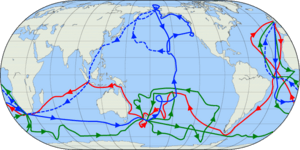
The Royal Navy played a big part in many global explorations and scientific discoveries. Starting in the 1700s, many voyages were ordered, often with the Royal Society. These included the Northwest Passage expedition of 1741. James Cook led three major voyages. His goals included finding Terra Australis, observing the Transit of Venus, and searching for the North-West Passage. These voyages greatly added to world knowledge and science. In the late 1700s, Captain George Vancouver made detailed maps of the western coast of North America during a four-year voyage.
In the 1800s, Charles Darwin made important scientific discoveries during the second voyage of HMS Beagle. The Ross expedition to the Antarctic found many new things in biology and zoology. Some Royal Navy voyages ended in disaster, like those of Franklin and Scott. Between 1872 and 1876, HMS Challenger carried out the first global marine research expedition, known as the Challenger expedition.
World War I

During World War I, most of the Royal Navy's power was at home in the Grand Fleet. It faced the German High Seas Fleet across the North Sea. There were several battles that didn't have a clear winner, mainly the Battle of Jutland in 1916. The British advantage in fighting was too great, so the High Seas Fleet stopped trying to challenge British control of the seas. The Royal Navy also played a key role in protecting the British Isles and the English Channel. It transported the entire British Expeditionary Force to the Western Front at the start of the war without losing a single life.
The Royal Navy was also active in other areas. This included the Mediterranean Sea, where they fought in the Dardanelles and Gallipoli campaigns in 1914 and 1915. British cruisers hunted down German merchant ships raiding across the world's oceans in 1914 and 1915. These battles included Coronel, Falklands Islands, Cocos, and Rufiji Delta.
Between the World Wars
After World War I, the Royal Navy was still the most powerful navy in the world. It was larger than the U.S. Navy and French Navy combined. It was also more than twice as large as the Imperial Japanese Navy and Royal Italian Navy combined. Its main rival, the Imperial German Navy, was destroyed at the end of the war. In the years between the wars, the Royal Navy lost much of its power. Treaties like the Washington and London Naval Treaties forced it to scrap some large warships and limited new construction.
In 1932, the Invergordon Mutiny happened in the Atlantic Fleet. Sailors protested against a proposed 25% pay cut, which was later reduced to 10%. As international tensions grew in the mid-1930s, the Royal Navy began re-arming by 1938. New ships were built, and older battleships, battlecruisers, and heavy cruisers were rebuilt. Anti-aircraft weapons were improved, and new technologies like ASDIC (for detecting submarines) were developed.
World War II
At the start of World War II in 1939, the Royal Navy was still the largest in the world, with over 1,400 ships. The Royal Navy provided vital protection during Operation Dynamo, the British evacuations from Dunkirk. It also acted as the ultimate defense against a German invasion of Britain. The Luftwaffe tried to gain control of the air over southern England in the Battle of Britain to weaken the Home Fleet. However, they faced strong resistance from the Royal Air Force.
The Royal Navy's most important fight was the Battle of the Atlantic. It defended Britain's crucial supply lines from North America against U-boat attacks. A traditional convoy system was started at the beginning of the war. However, German submarine tactics, using group attacks called "wolf-packs", were very effective. The threat remained serious for over three years.
After the Cold War
After the Soviet Union collapsed and the Cold War ended in 1991, the Royal Navy's fleet size gradually decreased. This was due to the changed global situation. While new and more capable ships like the Queen Elizabeth-class aircraft carriers and Astute-class submarines are being added, the total number of ships and submarines has continued to shrink. This has led to much discussion about the Royal Navy's size. A 2013 report found that the Royal Navy was already too small. It suggested Britain would have to rely on its allies if its territories were attacked.
The Royal Navy helped train the new Iraqi Navy and secured Iraq's oil terminals after fighting ended there. The mission finished in May 2011. The cost of nuclear deterrence, including Trident missile upgrades, has become a growing issue for the navy.
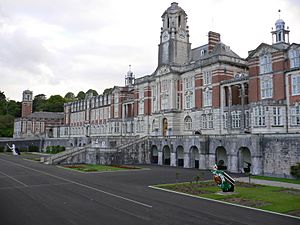
HMS Raleigh in Torpoint, Cornwall, is where new sailors get their basic training. Britannia Royal Naval College in Dartmouth, Devon is the first training place for Royal Navy officers. People in the Navy are divided into different groups. These include Warfare Officers and Naval Aviators, as well as engineers, medical staff, and logistics officers.
Today's officers and sailors have different uniforms. Some are for wearing on ships, others for ashore or for special ceremonies. Women started joining the Royal Navy in 1917 with the Women's Royal Naval Service (WRNS). The WRNS was stopped after World War I but brought back in 1939. It continued until 1993, when women were fully included in all parts of the Royal Navy. Women now serve in all areas, including the Royal Marines.
In August 2019, the Ministry of Defence reported that the Royal Navy and Royal Marines had 29,090 full-time trained people. Their goal was 30,600. In 2023, it was reported that the Royal Navy was having trouble recruiting. It saw a net drop of about 1,600 people (4% of the force) from mid-2022 to mid-2023. This made it harder for the navy to meet its duties.
Surface Fleet: Ships on the Water
Aircraft Carriers
The Royal Navy has two Queen Elizabeth-class aircraft carriers. Each carrier cost £3.2 billion. They are designed to operate the F-35 Lightning II aircraft, which can take off and land vertically. The first carrier, HMS Queen Elizabeth, started flight trials in 2018. It began sea trials in June 2017, was officially put into service later that year, and became fully active in 2020. The second carrier, HMS Prince of Wales, started sea trials in September 2019, was put into service in December 2019, and became operational in October 2021. These aircraft carriers are a key part of the UK Carrier Strike Group.
Amphibious Warfare Ships
Until 2024, the Royal Navy had two landing platform docks (HMS Albion and HMS Bulwark). Their main job was to carry out amphibious warfare, but they also helped with humanitarian aid missions. Both ships were in reserve in 2024. In November 2024, the new government said they would be fully retired by March 2025. This raised questions about the future of the navy's amphibious capabilities.
Clearance Divers
The Royal Navy's clearance diving unit, the Fleet Diving Squadron, was reorganized and renamed the Diving and Threat Exploitation Group in 2022. This group has five squadrons. The Royal Navy also has a separate unit of divers in the special forces unit, the Special Boat Service.
Escort Ships: Destroyers and Frigates

The escort fleet includes guided missile destroyers and frigates. These are the Navy's main working ships. As of July 2025, there are six Type 45 destroyers and eight Type 23 frigates in service. Their main job is to protect larger ships from air, surface, and underwater threats. They also carry out the Royal Navy's standing deployments around the world. These often involve stopping piracy and providing humanitarian aid.
The Type 45 destroyers are mainly designed for anti-aircraft and anti-missile warfare. The Royal Navy says their mission is to "shield the Fleet from air attack." They have the PAAMS (Sea Viper) air defense system. This system includes advanced radars and Aster 15 and 30 missiles.
Sixteen Type 23 frigates were delivered to the Royal Navy. The last one, HMS St Albans, was put into service in June 2002. However, a 2004 review decided that three frigates would be removed to save money. These were later sold to the Chilean Navy. The 2010 defense review announced that the remaining 13 Type 23 frigates would eventually be replaced by the Type 26 Frigate. The retirement of the Type 23s began in 2021. The 2015 defense review reduced the number of Type 26s to eight. Five Type 31e frigates were also planned.
Mine Countermeasure Vessels (MCMV)
The Royal Navy has two types of MCMVs: one Sandown-class minehunter and six Hunt-class mine countermeasures vessels. All Sandown-class ships will be removed from service by 2025. They are being replaced by robotic systems that will operate from other vessels. The Hunt-class ships can act as both traditional minesweepers and active minehunters. They can also be used as offshore patrol vessels if needed.
Offshore Patrol Vessels (OPV)
A fleet of eight River-class offshore patrol vessels are used by the Royal Navy. The three older Batch 1 ships patrol UK waters, protecting sovereignty and fisheries. The five newer Batch 2 ships are sent long-term to places like Gibraltar, the Caribbean, the Falkland Islands, and the Indo-Pacific region.
In December 2019, the Batch 1 River-class ship, HMS Clyde, was taken out of service. The Batch 2 HMS Forth took over its duties as the Falkland Islands patrol ship.
Survey Ships
HMS Protector is a special Antarctica patrol ship. It supports the British Antarctic Survey (BAS). HMS Scott is an ocean survey vessel. At 13,500 tonnes, it is one of the Navy's largest ships. As of 2018, the newly commissioned HMS Magpie also does survey work at sea. The Royal Fleet Auxiliary plans to add two new Multi-Role Ocean Surveillance Ships. These will help protect undersea cables and gas pipelines. The first of these, RFA Proteus, started service in October 2023.
Royal Fleet Auxiliary (RFA)
The Royal Fleet Auxiliary (RFA) helps the Royal Navy at sea in many ways. For example, it has ships that resupply the fleet. It has one Fleet Solid Support Ship (in reserve as of late 2024) and four fleet tankers. The RFA also has one aviation training and casualty reception vessel, RFA Argus.
Three amphibious transport docks are also part of its fleet. These are the Bay-class landing ships. Four were introduced in 2006–2007, but one was sold to the Royal Australian Navy in 2011. In November 2006, the First Sea Lord, Admiral Sir Jonathon Band, said the Royal Fleet Auxiliary vessels were "a major boost to the Royal Navy's war fighting ability."
In February 2023, a commercial vessel was bought to be a Multi-Role Ocean Surveillance (MROS) Ship. This ship, RFA Proteus, protects important seabed infrastructure. Another vessel, RFA Stirling Castle, was acquired in 2023 to act as a "mothership" for robotic minehunting systems.
Submarine Service: The Silent Force
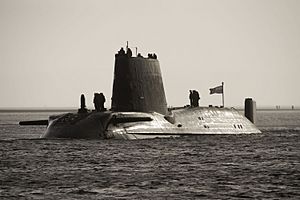
The Submarine Service is the part of the Royal Navy that uses submarines. It is sometimes called the "Silent Service" because submarines usually need to operate without being detected. The service started in 1901. In 1982, during the Falklands War, HMS Conqueror made history. It became the first nuclear-powered submarine to sink a surface ship, ARA General Belgrano. Today, all Royal Navy submarines are nuclear-powered.
Ballistic Missile Submarines (SSBN)
The Royal Navy has four Vanguard-class ballistic missile submarines. These submarines weigh almost 16,000 tonnes. They are armed with Trident II missiles (which carry nuclear weapons) and heavyweight Spearfish torpedoes. They carry out Operation Relentless, which is the United Kingdom's Continuous At Sea Deterrent (CASD). The UK government is replacing these submarines with four new Dreadnought-class submarines. These new submarines will start service in the early 2030s to continue this important role.
Fleet Submarines (SSN)
As of May 2025, five fleet submarines of the Astute-class are in service. The older Trafalgar class submarines have been removed from service. Two more Astute-class fleet submarines are expected to join the fleet by the late 2020s.
The Astute-class submarines weigh 7,400 tonnes. They carry both Tomahawk land-attack missiles and Spearfish torpedoes. In 2022, HMS Anson was the newest Astute-class submarine to be put into service.
The Fleet Air Arm (FAA) is the part of the Royal Navy that flies naval aircraft. It started in 1912 with the creation of the Royal Flying Corps. The Fleet Air Arm currently operates the AW-101 Merlin HC4 helicopters (supporting the UK Commando Force). It also uses the AW-159 Wildcat HM2 and the AW101 Merlin HM2 for anti-submarine missions. The F-35B Lightning II jets are used for carrier strike missions.
Pilots who will fly helicopters train at No. 1 Flying Training School (1 FTS) at RAF Shawbury.
Royal Marines: Elite Commandos
The Royal Marines are a special light infantry force of commandos. They can be sent quickly to support the government's military and diplomatic goals overseas. The Royal Marines are organized into a highly mobile light infantry brigade (UK Commando Force). They also have 7 commando units, including 47 Commando (Raiding Group) Royal Marines and 43 Commando Fleet Protection Group Royal Marines. The Corps works in all environments and climates. They have special training in amphibious warfare, Arctic warfare, mountain warfare, and expeditionary warfare. The Royal Marines are also the main source of people for the Royal Navy's special forces unit, the Special Boat Service (SBS).
The Corps has its own fleet of landing craft and other vessels. It also includes the Royal Marines Band Service, which is the musical part of the Royal Navy.
The Royal Marines have been in constant action since they were formed. They often fight alongside the British Army. This includes wars like the Seven Years' War, the Napoleonic Wars, the Crimean War, World War I, and World War II. More recently, they were deployed in the Falklands War, the Gulf War, the Bosnian War, the Kosovo War, the Sierra Leone Civil War, the Iraq War, and the War in Afghanistan (2001–2021). The Royal Marines have international connections with allied marine forces, especially the United States Marine Corps and the Netherlands Marine Corps.
The King is the Commander-in-chief of the British Armed Forces. The main leader of the Royal Navy is the Lord High Admiral of the United Kingdom. This position was held by Prince Philip, Duke of Edinburgh from 2011 until his death in 2021. The Prime Minister of the United Kingdom is the actual commander-in-chief of the armed forces. The Secretary of State for Defence is the minister responsible for defense. The professional head of the Naval Service is the First Sea Lord and Chief of Naval Staff (1SL/CNS). This person is an admiral and a member of the Defence Council of the United Kingdom.
Organization of the Fleet
The Fleet Commander is in charge of making sure ships, submarines, and aircraft are ready for any operations the Government needs. The Fleet Commander works through the Navy Command Headquarters, based at HMS Excellent in Portsmouth. Daily command of ships, aircraft, and Royal Marines is split. Large operations like United Kingdom Carrier Strike Group 21 often fall under the Permanent Joint Headquarters in Northwood, London. At the same site, the Commander Operations (Royal Navy) oversees individual ships and patrolling submarines.
The Royal Navy was the first of the three armed forces to combine its personnel and training command with its operational command. This happened in 2005, creating Fleet Command, which became Navy Command in 2008.
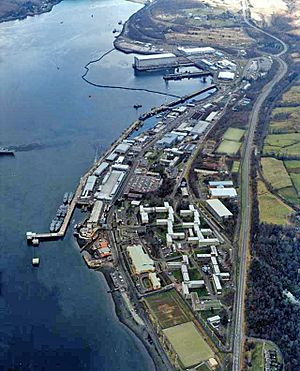
The Royal Navy currently operates from three bases in the United Kingdom where commissioned ships are based: Portsmouth, Clyde, and Devonport in Plymouth. Devonport is the largest operational naval base in the UK and Western Europe. Each base has a flotilla command led by a commodore. This person is responsible for making sure the ships and submarines in their flotilla are ready for operations. The UK Commando Force is also commanded by a brigadier and is based in Plymouth.
The Royal Navy has historically had Royal Navy Dockyards around the world. Dockyards are harbors where ships are repaired and refitted. Only four are operating today: at Devonport, Faslane, Rosyth, and Portsmouth.
The academy where future Royal Navy officers get their first training is Britannia Royal Naval College. It is located on a hill overlooking Dartmouth, Devon. Basic training for future sailors takes place at HMS Raleigh in Torpoint, Cornwall, near HMNB Devonport.
Bases in the United Kingdom


- HMNB Devonport (HMS Drake) – This is the largest operational naval base in Western Europe. Most of the Type 23 frigates are based here.
- HMNB Portsmouth (HMS Nelson) – This is home to the Queen Elizabeth-class aircraft carriers. Portsmouth is also home to the Type 45 Daring Class Destroyers and some Type 23 frigates.
- HMNB Clyde (HMS Neptune) – Located in Central Scotland along the River Clyde. Faslane is known as the home of the UK's nuclear deterrent. It houses the Vanguard-class ballistic missile (SSBN) submarines and the Astute-class fleet (SSN) submarines. Faslane will become the home for all Royal Navy submarines.
- RNAS Yeovilton (HMS Heron) – Yeovilton is home to the Commando Helicopter Force and Wildcat Maritime Force.
- RNAS Culdrose (HMS Seahawk) – This base is home to Mk2 Merlins, which mainly conduct Anti-Submarine Warfare (ASW) and Early Airborne Warning (EAW). Culdrose is currently the largest helicopter base in Europe.
Bases Abroad
- UK National Support Element (Bahrain) – This is the home port for ships sent on Operation Kipion. It is the center of the Royal Navy's operations in the Persian Gulf, Red Sea, and Indian Ocean.
- UK Joint Logistics Support Base (Oman) – A base for supplies located in the Middle East, outside the Persian Gulf.
- British Defence Singapore Support Unit (Singapore) – A remaining part of the former HMNB Singapore. It repairs and resupplies Royal Navy ships in the Asia Pacific.
- HMNB Gibraltar – A Royal Navy dockyard in Gibraltar still used for docking, repairs, training, and resupply.
- Mare Harbour (Falkland Islands) – This port supports RAF Mount Pleasant, the main British base in the Falkland Islands. It has berths for Royal Navy and marine services vessels in the South Atlantic.
Names and Titles
The navy was called the "Navy Royal" when it started in 1546. This name was used into the Stuart period. During the time when England was a Commonwealth, the fleet was called the "Commonwealth Navy." The navy was renamed the Royal Navy after the monarchy was restored in 1660.
Today, the UK's navy is commonly called the "Royal Navy" in the UK and other countries. Navies in other Commonwealth countries where the British monarch is also head of state include their national name, like the Royal Australian Navy.
Naming Ships
Royal Navy ships in service have the prefix "HMS" (His Majesty's Ship, or "Her Majesty's Ship" when the monarch is a queen). For example, HMS Beagle. Submarines are called HM Submarine, also shortened to "HMS." Names are given to ships and submarines by a committee in the Ministry of Defence. Names for ships in a class are often related to a theme (like the Type 23s, named after British dukes) or are traditional names. The monarch officially approves all ship names. Names are often reused, giving a new ship the history and traditions of older ships.
Ranks and Insignia
The Royal Navy's ranks, rates, and insignia are part of its uniform. The Royal Navy uniform style is used as a basis for many other navies around the world.
| Royal Navy officer rank insignia | |||||||||||||
|---|---|---|---|---|---|---|---|---|---|---|---|---|---|
| NATO Code | OF-10 | OF-9 | OF-8 | OF-7 | OF-6 | OF-5 | OF-4 | OF-3 | OF-2 | OF-1 | OF(D) | ||
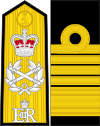 |
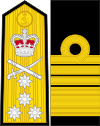 |
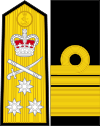 |
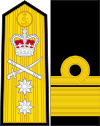 |
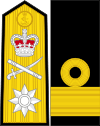 |
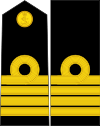 |
 |
 |
 |
 |
 |
 |
||
| Rank Title: | Admiral of the Fleet | Admiral | Vice admiral | Rear admiral | Commodore | Captain | Commander | Lieutenant commander | Lieutenant | Sub-Lieutenant | Midshipman | Officer Cadet | |
| Abbreviation: | Adm. of the Fleet | Adm | VAdm | RAdm | Cdre | Capt | Cdr | Lt Cdr | Lt | Sub Lt / SLt | Mid | OC | |
| Royal Navy other rank insignia | |||||||
|---|---|---|---|---|---|---|---|
| NATO Code | OR-9 | OR-8 | OR-7 | OR-6 | OR-5 | OR-4 | OR-2 |
 |
 |
 |
 |
 |
 |
||
| Rank Title: | Warrant Officer 1 | Warrant Officer 2 | Chief Petty Officer | Petty Officer | Leading Rating | Able Rating | |
| Abbreviation: | WO1 | WO2 | CPO | PO | LH | AB | |
Customs and Traditions
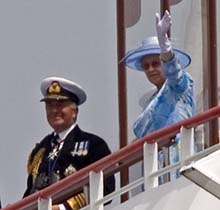
The Royal Navy has many formal customs and traditions, including the use of flags (ensigns) and ship badges. Royal Navy ships use different ensigns when sailing and when in port. Ships in service fly the White Ensign at the back of the ship when docked during the day and at the main mast when sailing. When docked, the Union Jack is flown from the front of the ship. It can only be flown while sailing to show a court-martial is happening or if an admiral of the fleet (including the Lord High Admiral or the monarch) is on board.
The Fleet Review is a special tradition where the fleet gathers before the monarch. The first recorded review was in 1400. The most recent one was on June 28, 2005, to mark 200 years since the Battle of Trafalgar. 167 ships from many nations attended, with the Royal Navy providing 67.
There are also less formal traditions, like nicknames and naval slang, known as "Jackspeak". Nicknames for the Navy include "The Andrew" and "The Senior Service." British sailors are called "Jack" (or "Jenny"), or more generally "Matelots." Royal Marines are often called "Bootnecks" or "Royals." A collection of Naval slang was put together by Commander A.T.L. Covey-Crump. A game traditionally played by the Navy is "Uckers". This is similar to Ludo and is easy to learn but hard to play well.
The Royal Navy supports three youth organizations:
- Volunteer Cadet Corps – This includes Royal Naval Volunteer Cadet Corps and Royal Marines Volunteer Cadet Corps. It was the first youth organization officially supported by the Admiralty in 1901.
- Combined Cadet Force – Found in schools, specifically the Royal Navy Section and the Royal Marines Section.
- Sea Cadets – This group supports teenagers interested in naval matters. It includes the Sea Cadets and the Royal Marines Cadets.
These organizations are overseen by the CUY branch of Commander Core Training and Recruiting (COMCORE).
See also
 In Spanish: Marina Real británica para niños
In Spanish: Marina Real británica para niños
- List of ship names of the Royal Navy (a full historical list)
- List of naval vessels of the United Kingdom
- List of equipment in the Royal Navy
- List of wars involving the United Kingdom
- His Majesty's Coastguard
- Royal British Legion
- Royal Hospital School
- Royal Naval Association
- "Rule, Britannia!", a famous song





